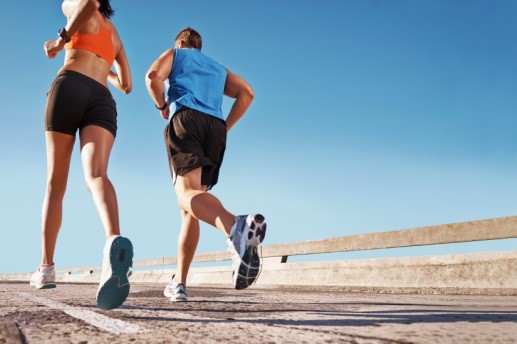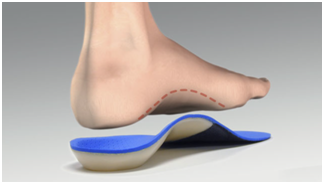Blog
Proper Supportive Footwear can Prevent Long Term Foot Problems
 Whether you were born with perfect feet or have every ailment possible in your lower extremities, it is necessary to have the proper footwear to avoid future pain and practice every day foot care. Often time many common foot problems such as plantar fasciitis, heel spurs, and hammertoes occur because of ill-fitting and unsupportive footwear. By having your foot fitting for the best type of shoe that suits your needs, you are treating and preventing foot complications.
Whether you were born with perfect feet or have every ailment possible in your lower extremities, it is necessary to have the proper footwear to avoid future pain and practice every day foot care. Often time many common foot problems such as plantar fasciitis, heel spurs, and hammertoes occur because of ill-fitting and unsupportive footwear. By having your foot fitting for the best type of shoe that suits your needs, you are treating and preventing foot complications.
Finding shoes with the proper fit and support is only one portion in maintaining everyday foot care. For more information about everyday foot care, consult with one of our podiatrists of Michigan Foot and Ankle. Our doctors will provide you with the foot- and ankle information you seek.
Every Day Foot Care
Often, people take care of their bodies, face and hair more so than they do for their feet. But the feet are a very important aspect of our bodies, and one that we should pay more attention to. After all, without our feet, we would not be able to perform most daily tasks. It is best to check your feet regularly to make sure there are no new bruises or cuts that you may not have noticed before, for example.
For dry feet, moisturizer can easily be a remedy and can be applied as often as necessary to the affected areas. Wearing shoes that fit well can also help you maintain good foot health, as well as making it easier to walk and do daily activities without the stress or pain of ill-fitting shoes, high heels, or even flip flops.
Also, wearing clean socks with closed shoes is important to ensure that sweat and bacteria do not accumulate within the shoe. Clean socks help to prevent athlete’s foot, fungi problems, bad odors, and can absorb sweat.
If you have any questions, please feel free to contact our offices, located in Ferndale, Milford, and Commerce Township, MI. We offer the newest diagnostic and treatment technologies for all of your foot ankle injuries.
Read more about Everyday Foot Care
Women more likely to develop Stress Fractures
 Studies have shown that women are at a greater risk of developing stress fractures than men. Reasons for this increased risk include hormonal differences, increased bone density, and higher rates of inadequate nutrition. While athletes in general are at highest risk after changes in intensity, frequency or duration of their workouts; in women, irregular menstrual cycles and weight less than 75 percent of ideal body weight are factors that make for an increased risk for stress fractures. Stress fractures are small cracks that develop in the bone after being stressed, and are most common in the foot, ankle, and lower leg but can occur on bones throughout the body.
Studies have shown that women are at a greater risk of developing stress fractures than men. Reasons for this increased risk include hormonal differences, increased bone density, and higher rates of inadequate nutrition. While athletes in general are at highest risk after changes in intensity, frequency or duration of their workouts; in women, irregular menstrual cycles and weight less than 75 percent of ideal body weight are factors that make for an increased risk for stress fractures. Stress fractures are small cracks that develop in the bone after being stressed, and are most common in the foot, ankle, and lower leg but can occur on bones throughout the body.
Stress fractures can become painful if left untreated for an extended period of time. If you would like assistance in treating a stress fracture in the foot or ankle, consult with Dr. Michael E. Newman of Pennsylvania. Our doctor can determine the severity of your condition and provide you with quality care.
Coping with Podiatric Stress Fractures
Stress Fractures occur on the foot and ankle when muscles in these areas weaken as a result of overexertion or underuse. As a result, the ankles and feet lose support when walking or running from the ground. Since these bones are not protected, they receive the full impact of each step. The stress on the feet causes the bones to form cracks.
What are Stress Fractures?
Stress Fractures are very common among those who are highly active and involved in sports or activities that make excessive use of their legs and feet. Stress fractures are especially common among:
-athletes (gymnasts, tennis players, basketball players)
-runners/joggers
-osteoporosis patients
-those who engage in high-intensity workouts
Stress Fracture Symptoms
Pain from the fractures occur in the area of the fractures, and can be either constant or periodic. The pain is usually sharp or dull, accompanied by swelling and tenderness. Engagement in any kind of high impact activity will exacerbate the pain.
For more information about Stress Fractures of the Foot and Ankle, follow the link below.
If you have any questions, please feel free to contact our offices located in Plymouth Meeting and Ambler, PA. We offer the newest diagnostic and treatment technologies for all your foot and ankle needs.
Avoid Running Injuries with Proper Training
 Improper training is the cause of about 56 percent of running injuries each year, reports Jason Fitzgerald, a 2:39 marathoner and USA Track & Field certified coach. Contrary to popular belief, proper running requires proper technique—similar to the way a football tackle or deadlift requires practice and skill.
Improper training is the cause of about 56 percent of running injuries each year, reports Jason Fitzgerald, a 2:39 marathoner and USA Track & Field certified coach. Contrary to popular belief, proper running requires proper technique—similar to the way a football tackle or deadlift requires practice and skill.
According to Fitzgerald, there are three general methods in avoiding injury: Avoid repeated use of the same part of the body and add variety to your training and distances, practice proactive recovery by adjusting your workouts by how you’re feeling day-to-day, and perfect your running form by counting your steps, avoiding over-striding, and standing up tall.
Running injuries, even with proper precautions, can still occur in many runners. If you are suffering from a running injury see Dr. Michael E. Newman from Pennsylvania. Our doctor will provide you with quality treatment and assist you with all of your foot and ankle concerns.
How to Prevent Running Injuries
Many common running injuries are caused by overuse and overtraining. When the back of the kneecap starts wearing out and starts causing pain in your knee, this is commonly referred to as runner’s knee. Runner’s knee is a decrease in strength in your quadriceps and can occur if you’re not wearing properly fitted or supporting shoes. To prevent runner’s knee, focusing on hip strengthening is a good idea, as well as strengthening your quads to keep the kneecaps aligned.
What Are Some Causes of Running Injuries?
- One cause of a common running injury is called iliotibial band syndrome.
- Plantar fasciitis is also another common injury.
- Stress fractures can occur from overtraining, lack of calcium, or even your running style.
Best Ways to Prevent Running Injuries
- Wear footwear that fits properly and suits your running needs.
- Running shoes are the only protective gear that runners have to safeguard them from injury.
- Make a training schedule. Adding strengthening exercises as well as regular stretching can help keep you strong and limber and can lessen the possibility of injuries.
- Stretching keeps muscles limber, this will help you gain better flexibility.
If you have any questions, please feel free to contact our offices located in Plymouth Meeting and Ambler, PA. We offer the newest diagnostic and treatment technologies for all your foot care needs.
Read more about How to Prevent Running Injuries
Early Signs of Flat Feet detectable in Children
 Children are in a constant state of growth and development and therefore often require frequent shopping trips to purchase items that will fit their growing bodies. Shoes often fall into this list of necessities, and with the purchase of new shoes parents should also keep in mind the necessity of proper foot health. Children in particular are prone to developing flat feet, a condition characterized by an abnormal collapse of the arch while standing. Parents can watch for early signs of the condition, which include: a flat foot arch at age 5 or older, heels that tend to angle outward when seen from the back, clumsiness during activity or early leg fatigue, or foot, knee or ankle pain during or after activity or the middle of the night.
Children are in a constant state of growth and development and therefore often require frequent shopping trips to purchase items that will fit their growing bodies. Shoes often fall into this list of necessities, and with the purchase of new shoes parents should also keep in mind the necessity of proper foot health. Children in particular are prone to developing flat feet, a condition characterized by an abnormal collapse of the arch while standing. Parents can watch for early signs of the condition, which include: a flat foot arch at age 5 or older, heels that tend to angle outward when seen from the back, clumsiness during activity or early leg fatigue, or foot, knee or ankle pain during or after activity or the middle of the night.
Certain sports and physical activities may become difficult for children with flat feet. If you suspect that your child has the condition, speak to Dr. Michael E. Newman of Pennsylvania. Our doctor will answer any of your foot and ankle related questions and attend to all of your podiatric needs.
What are Flat Feet?
Flat feet are a condition in which the arch of the foot is depressed and the sole of the foot is almost completely in contact with the ground. Standing about 20-30% of the population generally has flat feet because their arch never formed during growth.
Conditions & Problems:
Having flat feet makes it difficult to run or walk because of the stress placed on the ankles.
Alignment – The general alignment of your legs can be disrupted, because the ankles move inward which can cause major discomfort.
Knees – if you have complications with your knees, flat feet can be a contributor to arthritis in that area.
Symptoms:
Pain around the heel or arch area
Trouble standing on the tip toe.
Swelling around the inside of the ankle.
Flat look to one or both feet.
Having your shoes feel uneven when worn
Treatment:
If you are experiencing pain and stress on the foot you may weaken the posterior tibial tendon, which runs around the inside of the ankle.
For more information about Flat Feet, follow the link below.
If you have any questions, please feel free to contact our offices located in Plymouth Meeting and Ambler, PA. We offer the latest in diagnostic and treatment technologies to meet all your needs.
Read more about Flat Feet
